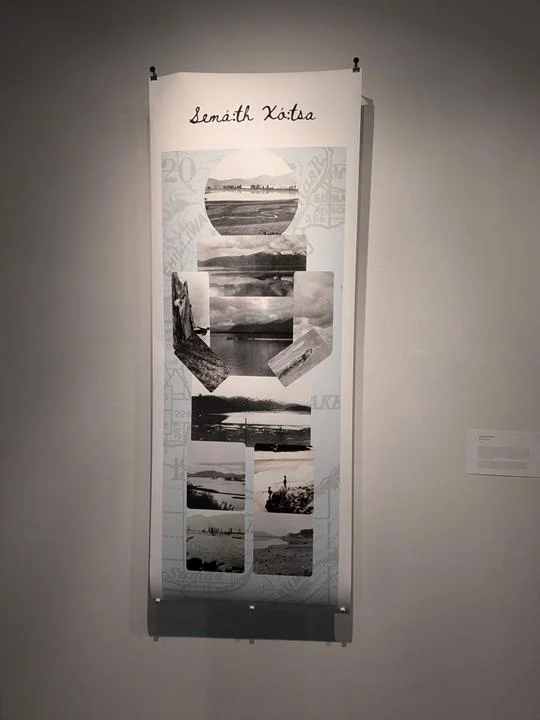Visitors to the S’eliyemetaxwtexw Art Gallery this March are invited to experience the relationships between land and body through performance. Curated by Luke Pardy and Anna Griffith, UFV alumni and faculty respectively, Land/Body Performance Archive brings together work from current students, alumni, and other artists in the community.
As Pardy explains, the collaboration was inspired by his own interdisciplinary practice and Griffith’s goals as a professor of theatre and performance arts, to support students in their explorations.
“Anna became interested in the work I was doing. We were talking about how there’s so much potential for students across SOCA in theatre, visual arts, in media arts to think about these connections between our bodies and land and also our bodies as land and land as body.”
Pardy and Griffith put out a call for artists in the fall and gathered seven exhibits from 11 artists. Pardy elected to model the exhibition after his experience attending NSCAD University — a Halifax based art school — showing pieces from both students and professionals.
“Our curatorial approach was to give an opportunity to current UFV students to show alongside practicing artists and faculty members in a non-hierarchical standard because, as an undergraduate student, you don’t always get that opportunity.”
This collection is unique as an archive of performance-based pieces. The idea of performance was one the curators wanted to embrace, encouraging a freedom of exploration from both artists and viewers alike.
“We’ve really thought about ‘what is performance?’ [in] a really broad sense, and so there [are] works that document performance art. There [are] interactive works in which the viewer becomes a performer. And then there’s work that comes out of performance-based research.”
In the gallery, the first noticeable pieces are fabric sheets hung successively with a projection of foliage shining on and through them. In Cobi Timmermans’ Sunlight on the Garden (2023) the visitor is invited to walk among the cloth and light to experience comfort and familiarity in new places.
Next is a body bag with a faceless white mask and candles around it; beside the bag is drug paraphernalia. The piece, Nameless, Faceless (2024-2025), also features photos hung above the installation, depicting the artist, Adam Nelson, laying inside the body bag, in the streets of Chilliwack.
In the back of the gallery, How Long It Takes One Leaf to Produce a Breath of Oxygen (2025), created by Candace Couse and Manjot Kaur, welcomes quiet contemplation. A projection of tree videos fills the back wall, adorned with shelves supporting jars filled with water and leaves. Each leaf has bubbles of oxygen clearly emerging from them.
The final piece, Stolen Land (2025) by Sterling Kai Pollock, features two posters layered together. The foremost has images of Sumas Lake, forming the shape of a person; the second poster holds a map of the area Sumas Lake once resided in.
As the exhibit and its performances are not limited to the space within the gallery, there are maps available to show visitors the locations of the work spread through Building C. According to Pardy, it’s a welcome opportunity.
“The space is also nice for people who maybe aren’t as familiar with the creative arts department on campus to come see what we’re doing over here.”
In Building C, there are two television screens to observe. One screen shows a single camera view of a jetty, with people interacting with nature and the man-made obstruction. The video, Pondering (Until It’s Water on Both Sides) (2022) by Sidi Chen, speaks to the queer experience in Vancouver, featuring a location popular within the local queer community.
The other screen shows three short videos of El Dorado, I am Colonial, Invasive Harvest (2024), depicting artist Uriel Guerrero-Acconcha exploring his Latin American identity while interacting with the B.C. landscape.
Continuing on to a small construct art room, Lumina Collective created a white molded 3D tree canvas on the wall with projection showing the changing seasons, as part of their work for Nature’s Pulse (2024). There are also scents being sprayed, a voice is heard speaking about the changing seasons, and when someone stands in a specific location, the installation reacts to the audience by altering the sounds and lights.
For both Pardy and Griffith, expanding the performances beyond the walls of the gallery is an important component of the archive’s theme. Not only does it spread awareness of creative programs on campus, but they also hope it brings connection and reflection to the spaces we occupy.
“Me and Anna both really like the idea of not containing the exhibition in just the gallery and activating more space around campus … and getting the viewer to walk and engage and recognize the land that they’re on.”
Land/Body Performance Archive runs from Mar. 10-28, both in the S’eliyemetaxwtexw Art Gallery and various displays throughout Building C.

